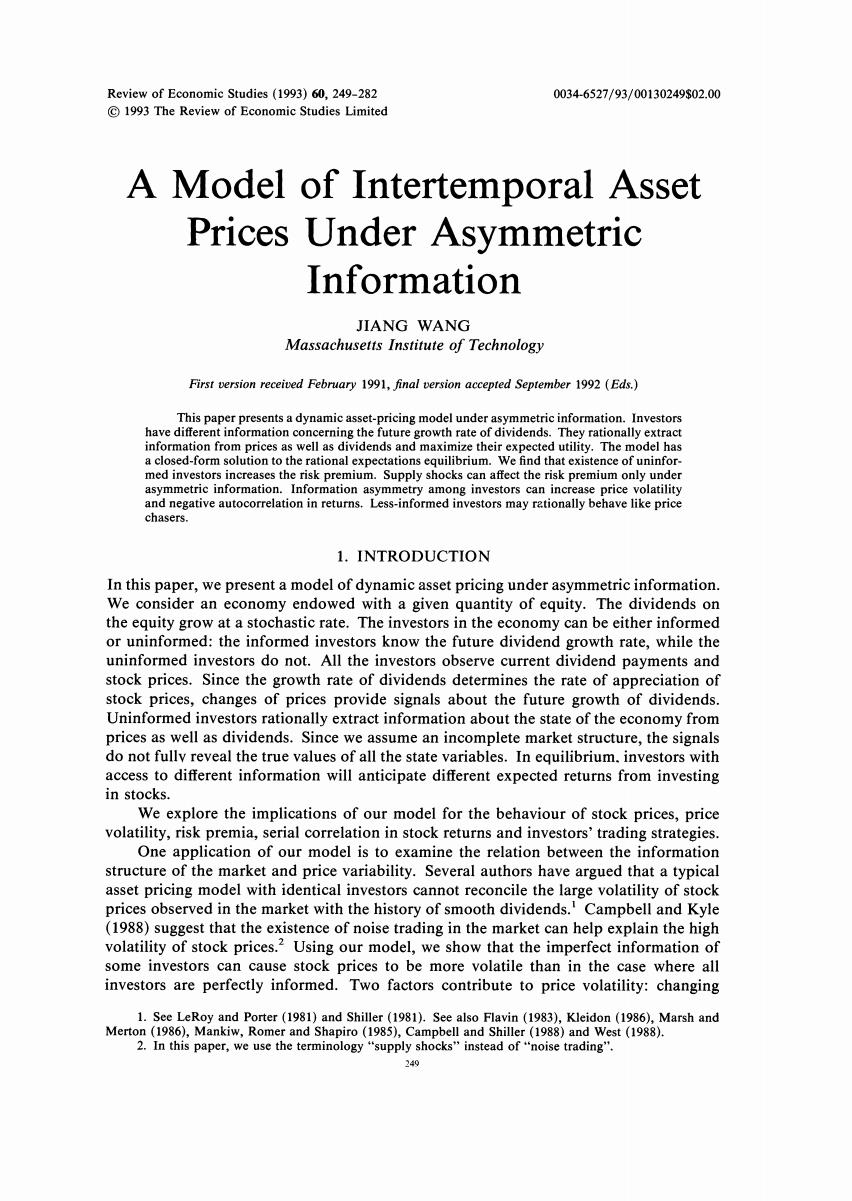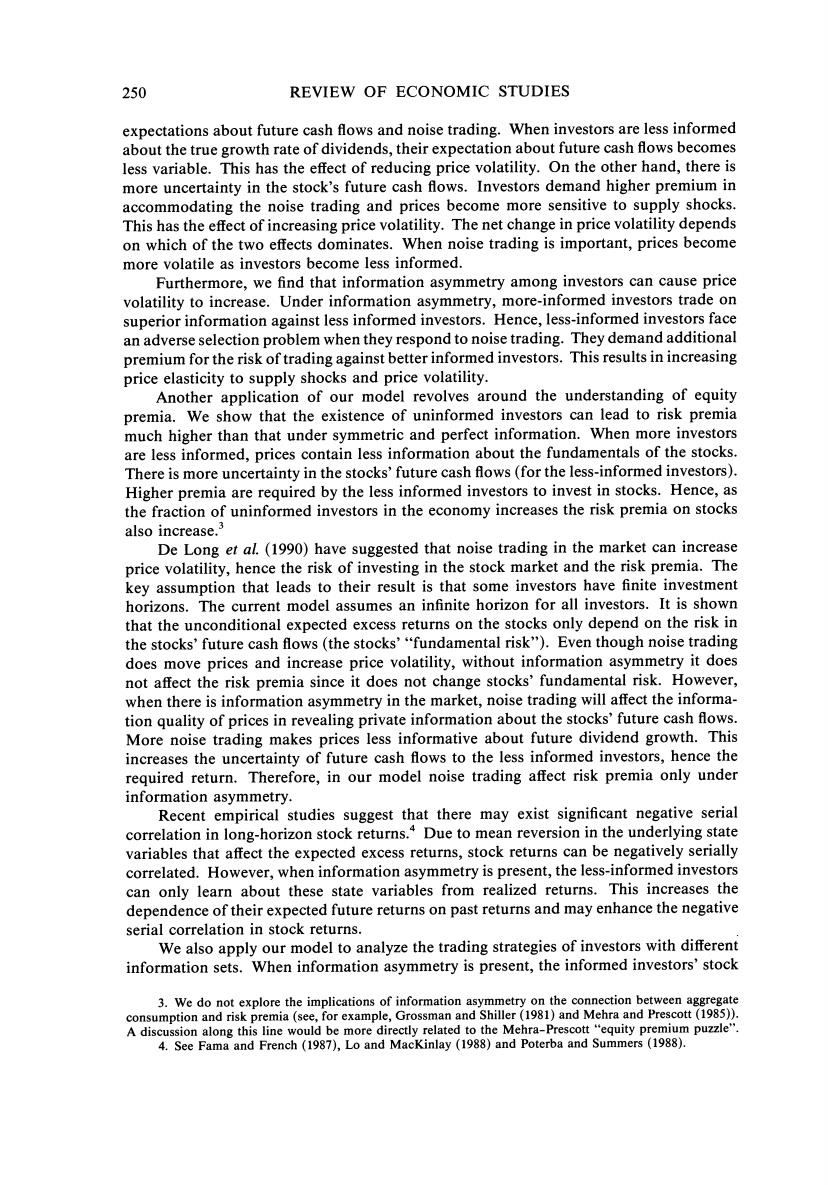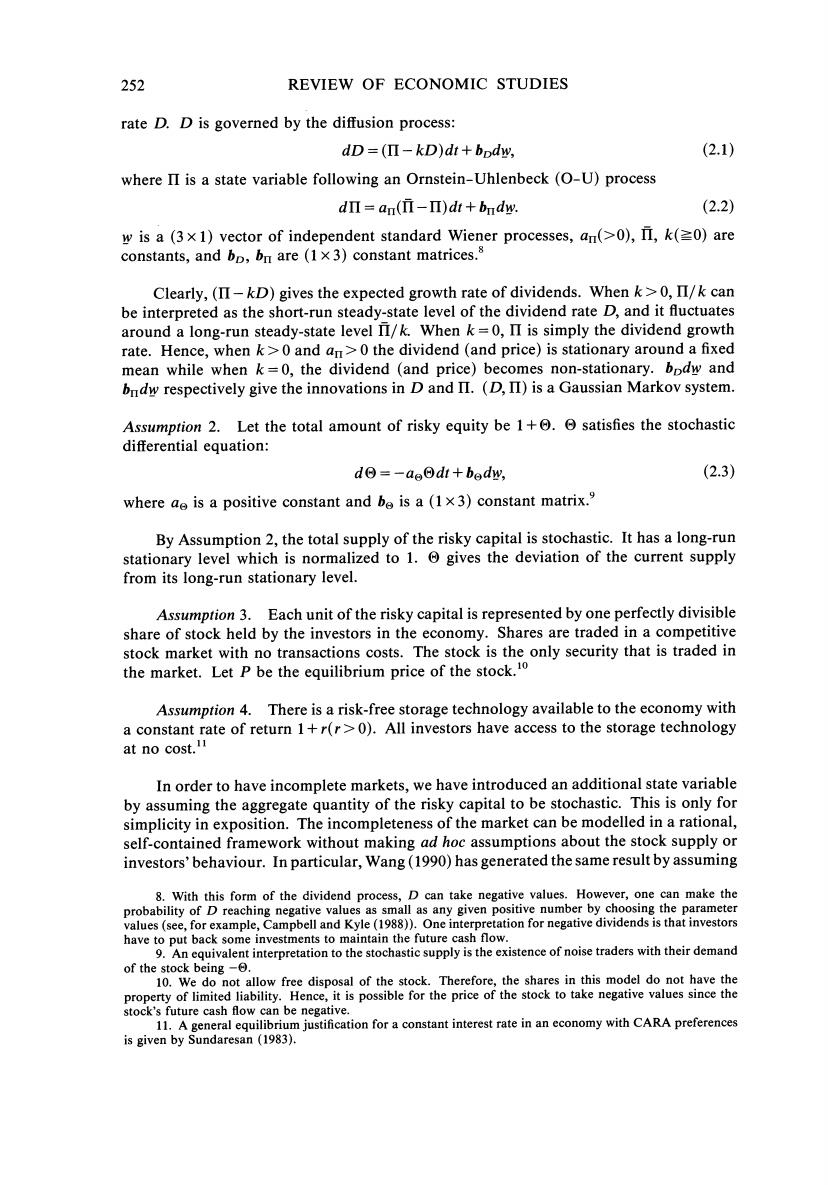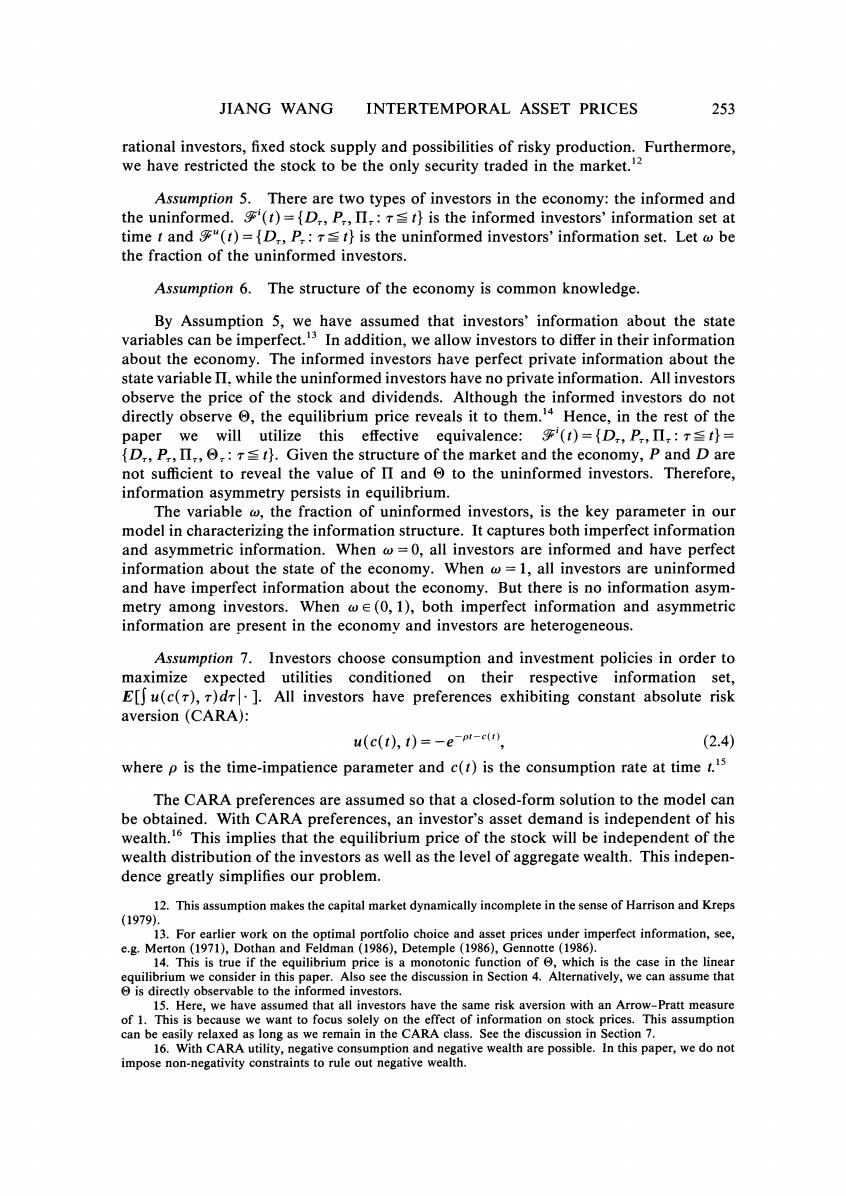
Review of Economic Studies(1993)60,249-282 0034-6527/93/00130249302.00 C 1993 The Review of Economic Studies Limited A Model of Intertemporal Asset Prices Under Asymmetric Information JIANG WANG Massachusetts Institute of Technology First version received February 1991,final version accepted September 1992 Eds.) This paper presents a dynamic asset-pricing model under asymmetric information.Investors have different information concerning the future growth rate of dividends.They rationally extract information from prices as well as dividends and maximize their expected utility.The model has a closed-form solution to the rational expectations equilibrium.We find that existence of uninfor- med investors increases the risk premium.Supply shocks can affect the risk premium only under asymmetric information.Information asymmetry among investors can increase price volatility and negative autocorrelation in returns.Less-informed investors may rationally behave like price chasers. 1.INTRODUCTION In this paper,we present a model of dynamic asset pricing under asymmetric information. We consider an economy endowed with a given quantity of equity.The dividends on the equity grow at a stochastic rate.The investors in the economy can be either informed or uninformed:the informed investors know the future dividend growth rate,while the uninformed investors do not.All the investors observe current dividend payments and stock prices.Since the growth rate of dividends determines the rate of appreciation of stock prices,changes of prices provide signals about the future growth of dividends Uninformed investors rationally extract information about the state of the economy from prices as well as dividends.Since we assume an incomplete market structure,the signals do not fully reveal the true values of all the state variables.In equilibrium.investors with access to different information will anticipate different expected returns from investing in stocks. We explore the implications of our model for the behaviour of stock prices,price volatility,risk premia,serial correlation in stock returns and investors'trading strategies. One application of our model is to examine the relation between the information structure of the market and price variability.Several authors have argued that a typical asset pricing model with identical investors cannot reconcile the large volatility of stock prices observed in the market with the history of smooth dividends.'Campbell and Kyle (1988)suggest that the existence of noise trading in the market can help explain the high volatility of stock prices.?Using our model,we show that the imperfect information of some investors can cause stock prices to be more volatile than in the case where all investors are perfectly informed.Two factors contribute to price volatility:changing 1.See LeRoy and Porter (1981)and Shiller (1981).See also Flavin (1983),Kleidon (1986),Marsh and Merton (1986),Mankiw,Romer and Shapiro (1985),Campbell and Shiller (1988)and West (1988). 2.In this paper,we use the terminology "supply shocks"instead of"noise trading". 249

250 REVIEW OF ECONOMIC STUDIES expectations about future cash flows and noise trading.When investors are less informed about the true growth rate of dividends,their expectation about future cash flows becomes less variable.This has the effect of reducing price volatility.On the other hand,there is more uncertainty in the stock's future cash flows.Investors demand higher premium in accommodating the noise trading and prices become more sensitive to supply shocks. This has the effect of increasing price volatility.The net change in price volatility depends on which of the two effects dominates.When noise trading is important,prices become more volatile as investors become less informed. Furthermore,we find that information asymmetry among investors can cause price volatility to increase.Under information asymmetry,more-informed investors trade on superior information against less informed investors.Hence,less-informed investors face an adverse selection problem when they respond to noise trading.They demand additional premium for the risk of trading against better informed investors.This results in increasing price elasticity to supply shocks and price volatility. Another application of our model revolves around the understanding of equity premia.We show that the existence of uninformed investors can lead to risk premia much higher than that under symmetric and perfect information.When more investors are less informed,prices contain less information about the fundamentals of the stocks. There is more uncertainty in the stocks'future cash flows(for the less-informed investors). Higher premia are required by the less informed investors to invest in stocks.Hence,as the fraction of uninformed investors in the economy increases the risk premia on stocks also increase. De Long et al.(1990)have suggested that noise trading in the market can increase price volatility,hence the risk of investing in the stock market and the risk premia.The key assumption that leads to their result is that some investors have finite investment horizons.The current model assumes an infinite horizon for all investors.It is shown that the unconditional expected excess returns on the stocks only depend on the risk in the stocks'future cash flows(the stocks'"fundamental risk").Even though noise trading does move prices and increase price volatility,without information asymmetry it does not affect the risk premia since it does not change stocks'fundamental risk.However, when there is information asymmetry in the market,noise trading will affect the informa- tion quality of prices in revealing private information about the stocks'future cash flows. More noise trading makes prices less informative about future dividend growth.This increases the uncertainty of future cash flows to the less informed investors,hence the required return.Therefore,in our model noise trading affect risk premia only under information asymmetry. Recent empirical studies suggest that there may exist significant negative serial correlation in long-horizon stock returns.Due to mean reversion in the underlying state variables that affect the expected excess returns,stock returns can be negatively serially correlated.However,when information asymmetry is present,the less-informed investors can only learn about these state variables from realized returns.This increases the dependence of their expected future returns on past returns and may enhance the negative serial correlation in stock returns. We also apply our model to analyze the trading strategies of investors with different information sets.When information asymmetry is present,the informed investors'stock 3.We do not explore the implications of information asymmetry on the connection between aggregate consumption and risk premia(see,for example,Grossman and Shiller(1981)and Mehra and Prescott(1985)). A discussion along this line would be more directly related to the Mehra-Prescott"equity premium puzzle". 4.See Fama and French(1987),Lo and MacKinlay(1988)and Poterba and Summers(1988)

JIANG WANG INTERTEMPORAL ASSET PRICES 251 holdings not only depend on the value of underlying state variables but also depend on the reaction of uninformed investors.Informed investors take advantage of the errors made by less-informed investors to make profits.The uninformed investors trade based on information extracted from prices and dividends.We find that in some cases,the uninformed investors rationally adopt trading strategies that look like trend chasing:they buy stocks when prices go up and sell when prices go down.A number of studies present evidence consistent with this type of trend-chasing strategy.3 Our results show that trend-chasing-like behaviour can be rational for less-informed investors under asymmetric information while informed investors behave as contrarians. There are two major obstacles in tackling the problem of dynamic asset pricing under asymmetric information.One is the notion of "no trading"and/or "fully revealing" (Grossman (1981),and Milgrom and Stokey (1985))and the other is the mathematical difficulty involved in deriving the equilibrium.The"no-trading theorem"states that if asymmetric information is the only motivation for trading,then an investor reveals his information to the market by his willingness to trade.Hence,information asymmetry is eliminated in equilibrium and no trade actually occurs as new information comes in. This result crucially depends on the market structure of the economy(see,e.g.,Grossman (1977,1981)).Under incomplete markets,there can be motivations other than the arrival of new information that cause investors to trade.In this case,the argument for the irrelevance of heterogeneous information breaks down.When information asymmetry is coupled with an incomplete market structure,the problem becomes mathematically involved.The current model,to our knowledge,is the first dynamic asset pricing model under asymmetric information which provides a closed-form solution. We organize the paper as follows.The formal model is spelled out in Section 2.In Section 3,we consider the simple situation in which investors have homogeneous and perfect information about the economy.This provides a benchmark case for our economy. A rational expectations equilibrium of the full model is obtained in Section 4 by sequen- tially solving the problems of investors'rational learning,optimization and market equilibrium.In Section 5,we investigate how the underlying information structure of the economy,especially information asymmetry,affects risk premia,price volatility and serial correlation in returns.In Section 6,we analyze the optimal investment strategies of investors with different information.Some further comments are provided in Section 7.Section 8 concludes. 2.THE ECONOMY We consider a simple economy with a single physical good.The economy is defined as follows. Assumption 1.The economy is endowed with a certain amount of risky equity. Each unit of the risky equity generates a flow of output(dividend)at an instantaneous 5.See,Anderassen and Kraus (1988),Case and Shiller (1988),Frenkel and Froot (1988)and Shiller (1987).See also Soros (1987). 6.See Duffie and Huang(1986)and He and Pearson(1988). 7.The information structure in this paper is similar to the one considered by Townsend (1981).Singleton (1985),Carino(1986)considered models in which all private information becomes public after a short period (one or two periods)so that effectively the less-informed investors'learning problem becomes a static one.In this paper,we allow private information to remain private.Therefore,the less-informed investors'learning problem becomes dynamic which generates interesting results concerning their optimal investment strategies and equilibrium prices

252 REVIEW OF ECONOMIC STUDIES rate D.D is governed by the diffusion process: dD=(II-kD)dt+bpdw, (2.1) where II is a state variable following an Ornstein-Uhlenbeck(O-U)process dΠ=an(n-Π)dt+bmdw. (2.2) w is a (3x1)vector of independent standard Wiener processes,an(>0),II,k(=0)are constants,and bp,bn are (1 x 3)constant matrices.3 Clearly,(II-kD)gives the expected growth rate of dividends.When k>0,II/k can be interpreted as the short-run steady-state level of the dividend rate D,and it fluctuates around a long-run steady-state level II/k.When k=0,II is simply the dividend growth rate.Hence,when k>0 and an>0 the dividend (and price)is stationary around a fixed mean while when k=0,the dividend (and price)becomes non-stationary.bpdw and bndw respectively give the innovations in D and II.(D,II)is a Gaussian Markov system. Assumption 2.Let the total amount of risky equity be 1+0.satisfies the stochastic differential equation: do=-ao⊙dt+badw, (2.3) where ae is a positive constant and be is a(1 x3)constant matrix. By Assumption 2,the total supply of the risky capital is stochastic.It has a long-run stationary level which is normalized to 1.gives the deviation of the current supply from its long-run stationary level. Assumption 3.Each unit of the risky capital is represented by one perfectly divisible share of stock held by the investors in the economy.Shares are traded in a competitive stock market with no transactions costs.The stock is the only security that is traded in the market.Let P be the equilibrium price of the stock.10 Assumption 4.There is a risk-free storage technology available to the economy with a constant rate of return 1+r(r>0).All investors have access to the storage technology at no cost.1 In order to have incomplete markets,we have introduced an additional state variable by assuming the aggregate quantity of the risky capital to be stochastic.This is only for simplicity in exposition.The incompleteness of the market can be modelled in a rational, self-contained framework without making ad hoc assumptions about the stock supply or investors'behaviour.In particular,Wang(1990)has generated the same result by assuming 8.With this form of the dividend process,D can take negative values.However,one can make the probability of D reaching negative values as small as any given positive number by choosing the parameter values(see,for example,Campbell and Kyle(1988)).One interpretation for negative dividends is that investors have to put back some investments to maintain the future cash flow. 9.An equivalent interpretation to the stochastic supply is the existence of noise traders with their demand of the stock being - 10.We do not allow free disposal of the stock.Therefore,the shares in this model do not have the property of limited liability.Hence,it is possible for the price of the stock to take negative values since the stock's future cash flow can be negative. 11.A general equilibrium justification for a constant interest rate in an economy with CARA preferences is given by Sundaresan (1983)

JIANG WANG INTERTEMPORAL ASSET PRICES 253 rational investors,fixed stock supply and possibilities of risky production.Furthermore, we have restricted the stock to be the only security traded in the market.12 Assumption 5.There are two types of investors in the economy:the informed and the uninformed.(t)={D,,P,II,:st}is the informed investors'information set at time t andg"(t)=[D,,P,:st}is the uninformed investors'information set.Let w be the fraction of the uninformed investors. Assumption 6.The structure of the economy is common knowledge. By Assumption 5,we have assumed that investors'information about the state variables can be imperfect.'3 In addition,we allow investors to differ in their information about the economy.The informed investors have perfect private information about the state variable II,while the uninformed investors have no private information.All investors observe the price of the stock and dividends.Although the informed investors do not directly observe the equilibrium price reveals it to them.14 Hence,in the rest of the paper we will utilize this effective equivalence:(t)=[D,,P,II,:t}= {D,,P,II,,,Tst}.Given the structure of the market and the economy,P and D are not sufficient to reveal the value of II and to the uninformed investors.Therefore, information asymmetry persists in equilibrium. The variable @the fraction of uninformed investors,is the key parameter in our model in characterizing the information structure.It captures both imperfect information and asymmetric information.When @=0,all investors are informed and have perfect information about the state of the economy.When @=1,all investors are uninformed and have imperfect information about the economy.But there is no information asym- metry among investors.When @e(0,1),both imperfect information and asymmetric information are present in the economy and investors are heterogeneous. Assumption 7.Investors choose consumption and investment policies in order to maximize expected utilities conditioned on their respective information set, E[J u(c(T),T)dr].All investors have preferences exhibiting constant absolute risk aversion(CARA): u(c(t),t)=-e-pr-c(n) (2.4) where p is the time-impatience parameter and c(t)is the consumption rate at time t.5 The CARA preferences are assumed so that a closed-form solution to the model can be obtained.With CARA preferences,an investor's asset demand is independent of his wealth.16 This implies that the equilibrium price of the stock will be independent of the wealth distribution of the investors as well as the level of aggregate wealth.This indepen- dence greatly simplifies our problem. 12.This assumption makes the capital market dynamically incomplete in the sense of Harrison and Kreps (1979). 13.For earlier work on the optimal portfolio choice and asset prices under imperfect information,see, e.g.Merton(1971),Dothan and Feldman(1986),Detemple(1986),Gennotte(1986). 14.This is true if the equilibrium price is a monotonic function of which is the case in the linear equilibrium we consider in this paper.Also see the discussion in Section 4.Alternatively,we can assume that 6 is directly observable to the informed investors. 15.Here,we have assumed that all investors have the same risk aversion with an Arrow-Pratt measure of 1.This is because we want to focus solely on the effect of information on stock prices.This assumption can be easily relaxed as long as we remain in the CARA class.See the discussion in Section 7. 16.With CARA utility,negative consumption and negative wealth are possible.In this paper,we do not impose non-negativity constraints to rule out negative wealth